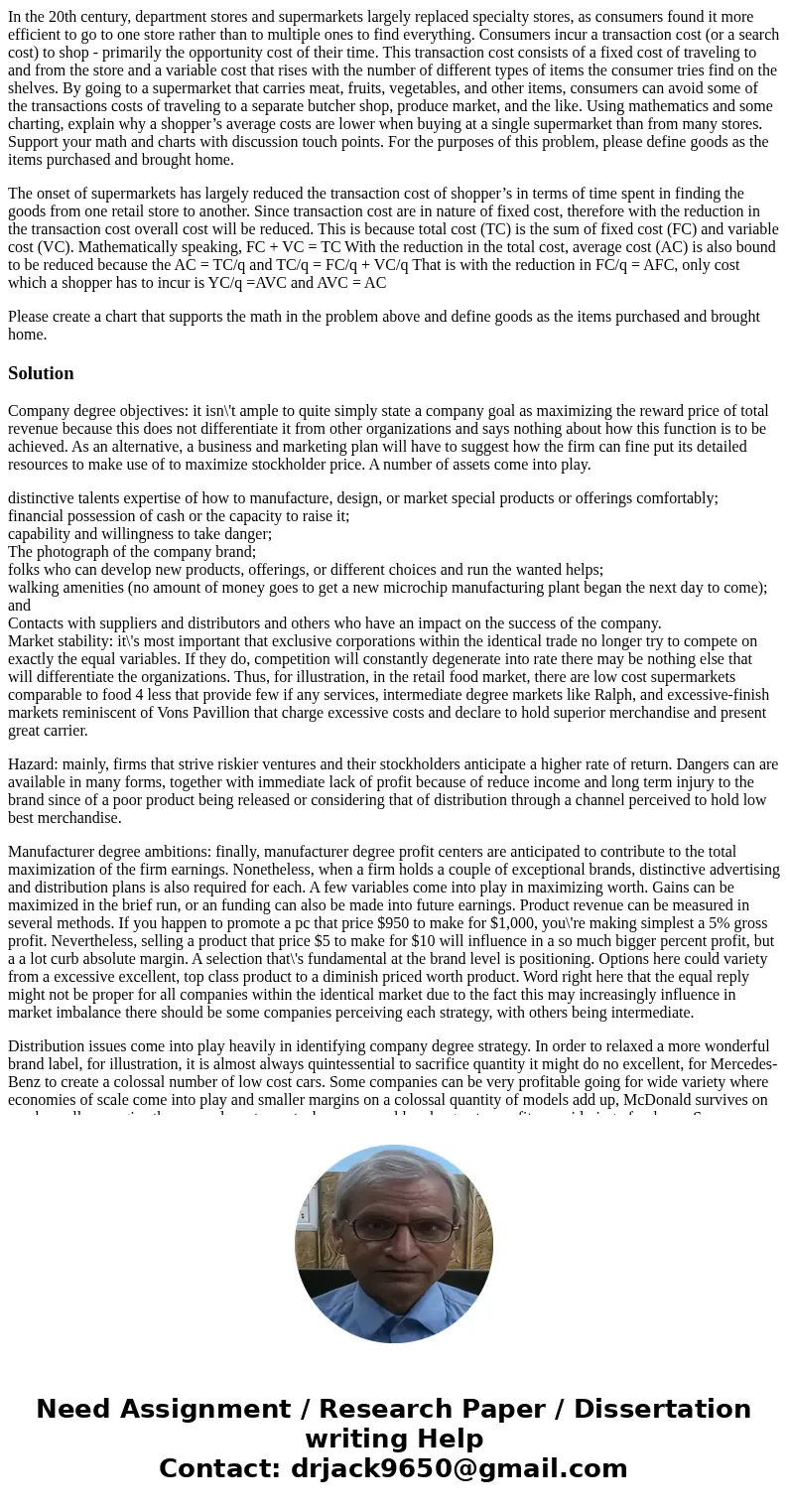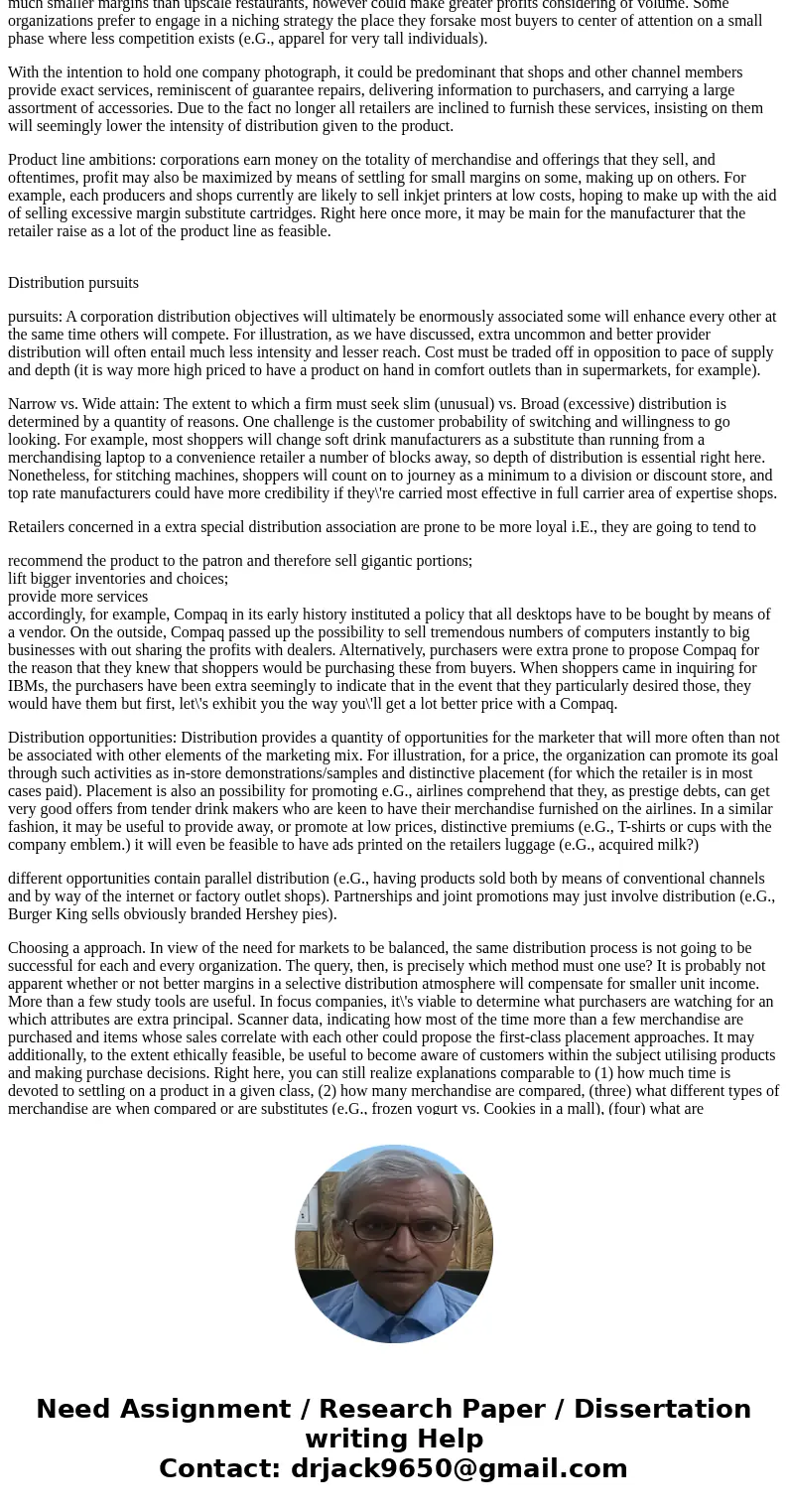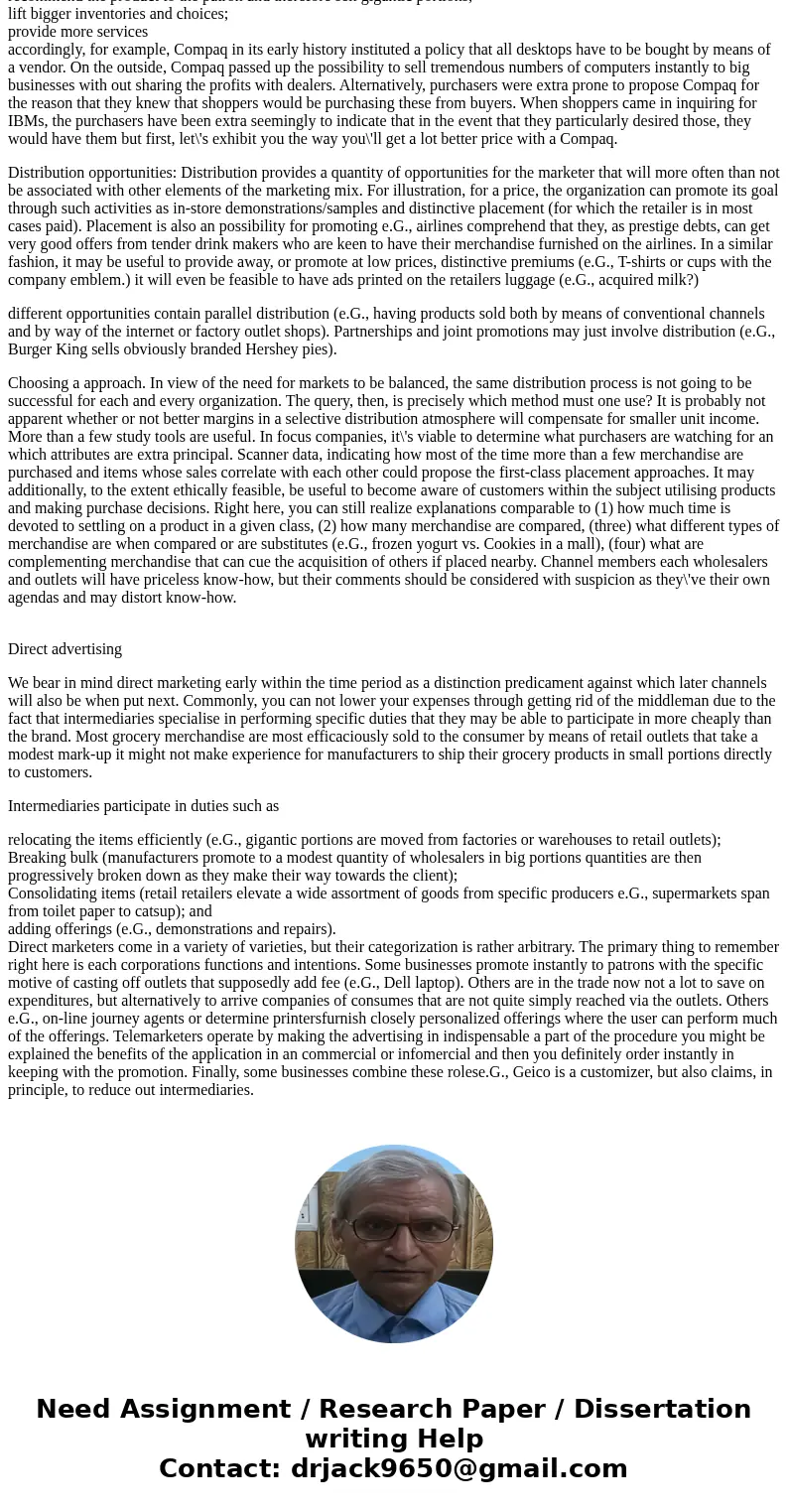In the 20th century department stores and supermarkets large
In the 20th century, department stores and supermarkets largely replaced specialty stores, as consumers found it more efficient to go to one store rather than to multiple ones to find everything. Consumers incur a transaction cost (or a search cost) to shop - primarily the opportunity cost of their time. This transaction cost consists of a fixed cost of traveling to and from the store and a variable cost that rises with the number of different types of items the consumer tries find on the shelves. By going to a supermarket that carries meat, fruits, vegetables, and other items, consumers can avoid some of the transactions costs of traveling to a separate butcher shop, produce market, and the like. Using mathematics and some charting, explain why a shopper’s average costs are lower when buying at a single supermarket than from many stores. Support your math and charts with discussion touch points. For the purposes of this problem, please define goods as the items purchased and brought home.
The onset of supermarkets has largely reduced the transaction cost of shopper’s in terms of time spent in finding the goods from one retail store to another. Since transaction cost are in nature of fixed cost, therefore with the reduction in the transaction cost overall cost will be reduced. This is because total cost (TC) is the sum of fixed cost (FC) and variable cost (VC). Mathematically speaking, FC + VC = TC With the reduction in the total cost, average cost (AC) is also bound to be reduced because the AC = TC/q and TC/q = FC/q + VC/q That is with the reduction in FC/q = AFC, only cost which a shopper has to incur is YC/q =AVC and AVC = AC
Please create a chart that supports the math in the problem above and define goods as the items purchased and brought home.
Solution
Company degree objectives: it isn\'t ample to quite simply state a company goal as maximizing the reward price of total revenue because this does not differentiate it from other organizations and says nothing about how this function is to be achieved. As an alternative, a business and marketing plan will have to suggest how the firm can fine put its detailed resources to make use of to maximize stockholder price. A number of assets come into play.
distinctive talents expertise of how to manufacture, design, or market special products or offerings comfortably;
financial possession of cash or the capacity to raise it;
capability and willingness to take danger;
The photograph of the company brand;
folks who can develop new products, offerings, or different choices and run the wanted helps;
walking amenities (no amount of money goes to get a new microchip manufacturing plant began the next day to come); and
Contacts with suppliers and distributors and others who have an impact on the success of the company.
Market stability: it\'s most important that exclusive corporations within the identical trade no longer try to compete on exactly the equal variables. If they do, competition will constantly degenerate into rate there may be nothing else that will differentiate the organizations. Thus, for illustration, in the retail food market, there are low cost supermarkets comparable to food 4 less that provide few if any services, intermediate degree markets like Ralph, and excessive-finish markets reminiscent of Vons Pavillion that charge excessive costs and declare to hold superior merchandise and present great carrier.
Hazard: mainly, firms that strive riskier ventures and their stockholders anticipate a higher rate of return. Dangers can are available in many forms, together with immediate lack of profit because of reduce income and long term injury to the brand since of a poor product being released or considering that of distribution through a channel perceived to hold low best merchandise.
Manufacturer degree ambitions: finally, manufacturer degree profit centers are anticipated to contribute to the total maximization of the firm earnings. Nonetheless, when a firm holds a couple of exceptional brands, distinctive advertising and distribution plans is also required for each. A few variables come into play in maximizing worth. Gains can be maximized in the brief run, or an funding can also be made into future earnings. Product revenue can be measured in several methods. If you happen to promote a pc that price $950 to make for $1,000, you\'re making simplest a 5% gross profit. Nevertheless, selling a product that price $5 to make for $10 will influence in a so much bigger percent profit, but a a lot curb absolute margin. A selection that\'s fundamental at the brand level is positioning. Options here could variety from a excessive excellent, top class product to a diminish priced worth product. Word right here that the equal reply might not be proper for all companies within the identical market due to the fact this may increasingly influence in market imbalance there should be some companies perceiving each strategy, with others being intermediate.
Distribution issues come into play heavily in identifying company degree strategy. In order to relaxed a more wonderful brand label, for illustration, it is almost always quintessential to sacrifice quantity it might do no excellent, for Mercedes-Benz to create a colossal number of low cost cars. Some companies can be very profitable going for wide variety where economies of scale come into play and smaller margins on a colossal quantity of models add up, McDonald survives on much smaller margins than upscale restaurants, however could make greater profits considering of volume. Some organizations prefer to engage in a niching strategy the place they forsake most buyers to center of attention on a small phase where less competition exists (e.G., apparel for very tall individuals).
With the intention to hold one company photograph, it could be predominant that shops and other channel members provide exact services, reminiscent of guarantee repairs, delivering information to purchasers, and carrying a large assortment of accessories. Due to the fact no longer all retailers are inclined to furnish these services, insisting on them will seemingly lower the intensity of distribution given to the product.
Product line ambitions: corporations earn money on the totality of merchandise and offerings that they sell, and oftentimes, profit may also be maximized by means of settling for small margins on some, making up on others. For example, each producers and shops currently are likely to sell inkjet printers at low costs, hoping to make up with the aid of selling excessive margin substitute cartridges. Right here once more, it may be main for the manufacturer that the retailer raise as a lot of the product line as feasible.
Distribution pursuits
pursuits: A corporation distribution objectives will ultimately be enormously associated some will enhance every other at the same time others will compete. For illustration, as we have discussed, extra uncommon and better provider distribution will often entail much less intensity and lesser reach. Cost must be traded off in opposition to pace of supply and depth (it is way more high priced to have a product on hand in comfort outlets than in supermarkets, for example).
Narrow vs. Wide attain: The extent to which a firm must seek slim (unusual) vs. Broad (excessive) distribution is determined by a quantity of reasons. One challenge is the customer probability of switching and willingness to go looking. For example, most shoppers will change soft drink manufacturers as a substitute than running from a merchandising laptop to a convenience retailer a number of blocks away, so depth of distribution is essential right here. Nonetheless, for stitching machines, shoppers will count on to journey as a minimum to a division or discount store, and top rate manufacturers could have more credibility if they\'re carried most effective in full carrier area of expertise shops.
Retailers concerned in a extra special distribution association are prone to be more loyal i.E., they are going to tend to
recommend the product to the patron and therefore sell gigantic portions;
lift bigger inventories and choices;
provide more services
accordingly, for example, Compaq in its early history instituted a policy that all desktops have to be bought by means of a vendor. On the outside, Compaq passed up the possibility to sell tremendous numbers of computers instantly to big businesses with out sharing the profits with dealers. Alternatively, purchasers were extra prone to propose Compaq for the reason that they knew that shoppers would be purchasing these from buyers. When shoppers came in inquiring for IBMs, the purchasers have been extra seemingly to indicate that in the event that they particularly desired those, they would have them but first, let\'s exhibit you the way you\'ll get a lot better price with a Compaq.
Distribution opportunities: Distribution provides a quantity of opportunities for the marketer that will more often than not be associated with other elements of the marketing mix. For illustration, for a price, the organization can promote its goal through such activities as in-store demonstrations/samples and distinctive placement (for which the retailer is in most cases paid). Placement is also an possibility for promoting e.G., airlines comprehend that they, as prestige debts, can get very good offers from tender drink makers who are keen to have their merchandise furnished on the airlines. In a similar fashion, it may be useful to provide away, or promote at low prices, distinctive premiums (e.G., T-shirts or cups with the company emblem.) it will even be feasible to have ads printed on the retailers luggage (e.G., acquired milk?)
different opportunities contain parallel distribution (e.G., having products sold both by means of conventional channels and by way of the internet or factory outlet shops). Partnerships and joint promotions may just involve distribution (e.G., Burger King sells obviously branded Hershey pies).
Choosing a approach. In view of the need for markets to be balanced, the same distribution process is not going to be successful for each and every organization. The query, then, is precisely which method must one use? It is probably not apparent whether or not better margins in a selective distribution atmosphere will compensate for smaller unit income. More than a few study tools are useful. In focus companies, it\'s viable to determine what purchasers are watching for an which attributes are extra principal. Scanner data, indicating how most of the time more than a few merchandise are purchased and items whose sales correlate with each other could propose the first-class placement approaches. It may additionally, to the extent ethically feasible, be useful to become aware of customers within the subject utilising products and making purchase decisions. Right here, you can still realize explanations comparable to (1) how much time is devoted to settling on a product in a given class, (2) how many merchandise are compared, (three) what different types of merchandise are when compared or are substitutes (e.G., frozen yogurt vs. Cookies in a mall), (four) what are complementing merchandise that can cue the acquisition of others if placed nearby. Channel members each wholesalers and outlets will have priceless know-how, but their comments should be considered with suspicion as they\'ve their own agendas and may distort know-how.
Direct advertising
We bear in mind direct marketing early within the time period as a distinction predicament against which later channels will also be when put next. Commonly, you can not lower your expenses through getting rid of the middleman due to the fact that intermediaries specialise in performing specific duties that they may be able to participate in more cheaply than the brand. Most grocery merchandise are most efficaciously sold to the consumer by means of retail outlets that take a modest mark-up it might not make experience for manufacturers to ship their grocery products in small portions directly to customers.
Intermediaries participate in duties such as
relocating the items efficiently (e.G., gigantic portions are moved from factories or warehouses to retail outlets);
Breaking bulk (manufacturers promote to a modest quantity of wholesalers in big portions quantities are then progressively broken down as they make their way towards the client);
Consolidating items (retail retailers elevate a wide assortment of goods from specific producers e.G., supermarkets span from toilet paper to catsup); and
adding offerings (e.G., demonstrations and repairs).
Direct marketers come in a variety of varieties, but their categorization is rather arbitrary. The primary thing to remember right here is each corporations functions and intentions. Some businesses promote instantly to patrons with the specific motive of casting off outlets that supposedly add fee (e.G., Dell laptop). Others are in the trade now not a lot to save on expenditures, but alternatively to arrive companies of consumes that are not quite simply reached via the outlets. Others e.G., on-line journey agents or determine printersfurnish closely personalized offerings where the user can perform much of the offerings. Telemarketers operate by making the advertising in indispensable a part of the procedure you might be explained the benefits of the application in an commercial or infomercial and then you definitely order instantly in keeping with the promotion. Finally, some businesses combine these rolese.G., Geico is a customizer, but also claims, in principle, to reduce out intermediaries.



 Homework Sourse
Homework Sourse